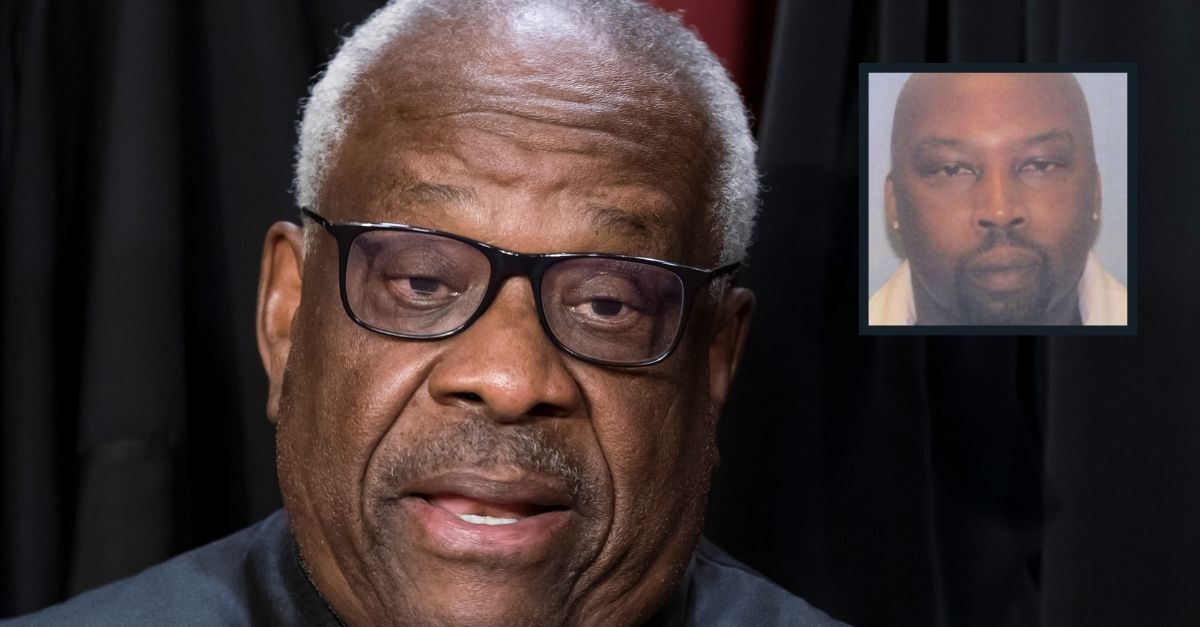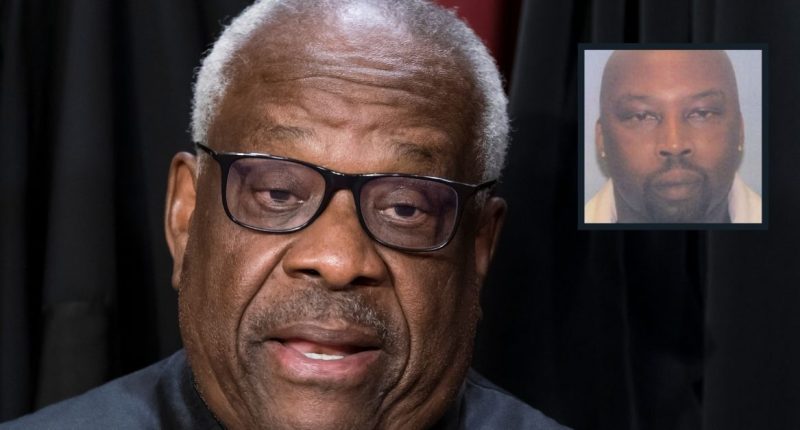
Background: Supreme Court Justice Clarence Thomas (Drew Angerer/Getty Images). Inset: David M. Smith (Portage County Police).
The Supreme Court denied a request to delay a new trial for an Ohio man convicted of attempted murder nearly a decade ago, and Justice Clarence Thomas issued yet another statement slamming the U.S. Court of Appeals for the Sixth Circuit for ruling that a defendant had been denied due process in state court.
David M. Smith was sentenced to 22 years in prison in November 2016 for attempting to murder Quortney Tolliver, 24, with a hammer. Smith’s trial relied on the victim’s identification statements made to police, which came after a detective told the victim that Smith had committed the crime.
The Sixth Circuit found that Smith’s conviction was based on an intentionally “unduly suggestive and coercive” identification that occurred while the victim was suffering from head trauma. It said that the Ohio courts “impermissibly excused this flagrant violation” of Smith’s due process rights and directed the district court to issue a writ of habeas corpus.
The Court’s two staunch conservatives, however, disagreed. Thomas penned a dissenting statement that was joined by Justice Samuel Alito — one in a line of similar dissents over the majority’s decision to side with the Sixth Circuit on due process cases.
In October 2015, Tolliver was attacked with a hammer in her mobile home in Portage County, Ohio. Tolliver was hospitalized for two weeks and placed in a medically induced coma. When she regained consciousness, police began to interview her about the attack. Initially, Tolliver communicated through hand signals and writing, unable to speak due to her injuries.
Tolliver was shown a photo array of 24 Black men, none of which was Smith, and Tolliver told police she had no memory of who attacked her. Over the course of the next few months, police continued to question Tolliver to see if she remembered anything about her attacker. Smith ultimately became the prime suspect after his DNA was found at the scene of the crime.
Lieutenant Greg Johnson, Chief of Detectives, met with Tolliver in December and told Tolliver that the police had found her assailant. Johnson showed Tolliver a large photo of Smith and asked if she recognized him. Tolliver initially did not recognize the photo at all, then after more questioning, said she had met him before through a mutual friend.
Johnson told Tolliver that Smith “wanted her dead,” had been previously imprisoned for attempted murder, and was “very violent,” and “cold-hearted.” Johnson also told Tolliver that Smith “believed Tolliver deserved to be attacked and that he had left Tolliver to die,” and argued with Tolliver that there could be no way Smith’s DNA could be in her mobile home unless he had been her attacker.
As the Sixth Circuit put it, “Overall, Johnson did not merely suggest that Smith was the perpetrator, but rather explicitly informed Tolliver several times that Smith committed the crime and tried to kill her.”
Although the district court ruled against Smith, the Sixth Circuit reversed and said that Tolliver’s unreliable identification should have been suppressed, and that as a result, Smith’s due process rights were violated.
The state of Ohio appealed the ruling to the Supreme Court in hopes that the justice would overturned the Sixth Circuit and deny Smith’s request for habeas corpus relief. However, the justices denied certiorari in the case Monday, thereby leaving the Sixth Circuit’s ruling in place.
Thomas and Alito again banded together to slam the Sixth Circuit for its incorrect application of federal law. In a 15-page statement penned by Thomas, he pronounced the Sixth Circuit’s ruling “the latest in a long line of Sixth Circuit AEDPA errors,” referring to the federal Anti-Terrorism and Effective Death Penalty Act, which the justices argue limits the federal courts’ power to grant habeas corpus relief.
Generally, under the AEDPA, federal courts are prohibited from granting habeas relief to state prisoners unless the underlying state ruling was based on “an unreasonable application of, clearly established Federal law, as determined by the Supreme Court of the United States.” Thomas has taken a particular dislike to the Sixth Circuit’s AEDPA rulings in recent years, at one point calling the Sixth Circuit’s jurisprudence “an insult to Congress and a disservice to the people” of multiple states.
In his dissenting statement on the Court’s denial of certiorari in the Smith case, Thomas explained that Tolliver was a crack dealer who told Smith “her supply had run out,” but that she would give Smith a discount on drugs if he drove her to Cleveland to replenish her supply. Then, on the day that the trip was to occur, Tolliver was brutally attacked.
To hear Thomas tell it, Tolliver had never been uncertain that Smith was her attacker. Rather, Tolliver failed to identify him because her mother was present during the police interviews and Tolliver did not want her mother to know she was a drug dealer. Tolliver herself was later arrested on drug charges, then volunteered that Smith had been her attacker.
Thomas said that the Sixth Circuit’s analysis had been completely wrong, with two errors having been “particularly egregious.” First, Thomas said, federal law bars habeas relief unless the state court’s decision was “unreasonable” — and that the Sixth Circuit did not do enough analysis to support a ruling of unreasonableness.
Second, the justice noted, the circuit court’s majority “erred by critiquing the Ohio court’s opinion-writing style rather than its judgment.” In its opinion, the circuit court chastised the state court for “halfheartedly devoting a couple sentences to its analysis.”
However, said Thomas, “a state court need not explain its reasoning at all.” According to the justice, just because the state court did not detail its analysis does not mean it did not conduct one.
Thomas went on to warn: “The panel majority’s errors have real consequences.
Now, because of the Sixth Circuit’s mistake, Ohio must retry Smith for a crime committed nearly a decade ago, said Thomas, who added that the result “comes at a steep cost for both society and the victim.”
Retrying Smith “diverts significant time and resources away from other law enforcement activities,” and the retrial will be harder because the passage of time make the entire process harder. Moreover, Smith might not be convicted next time, warned Thomas.
You can read the full dissenting statement here.









